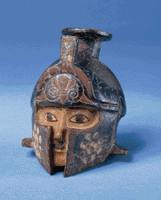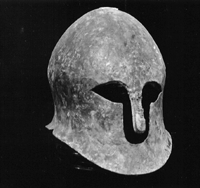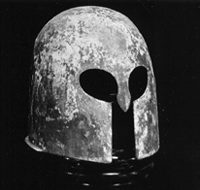|
Bronze ´Piceno-Corinthian´ Helmet
ca. 550 BC
Ascoli Piceno (ancient Asculum), Italy, Tomb of the
Warrior
MS 1534
This helmet originally carried a detachable horsehair crest.
In perhaps a local modification by the Piceni, a tribe of
central Italic people on the Adriatic coast northeast of
Rome, the protective cheek and lower jaw pieces are formed
from a single sheet of bronze. The nose piece has been
restored from another helmet.
H. 25.0; L. 24.6; W. 19.0 cm. UM neg. G6-10872 (larger
version)
|
Bronze ´Corinthian´ Helmet
ca. 600 BC
Italy
MS 1608
The most common type of helmet in use during the Archaic
period. Beaten out of a single sheet of bronze, it provided
good protection to the forehead, nose and cheek areas. The
two cheek pieces are separated to leave a gap exposing the
mouth. Its shape only approximates the contours of the human
skull, necessitating a fur or felt lining.
H. 20.5; L. 21.7; W. 18.9 cm. UM neg. G6-10872 (larger
version)
|


